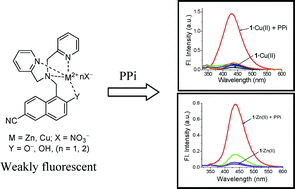Mononuclear Zn(ii)- and Cu(ii)-complexes of a hydroxynaphthalene-derived dipicolylamine: fluorescent sensing behaviours toward pyrophosphate ions†
Abstract
Mononuclear Zn(II)-DPA and Cu(II)-DPA complexes crafted on 2-hydroxy-6-cyanonaphthalene fluorophore selectively recognize PPi over ATP and other anions including


 Please wait while we load your content...
Please wait while we load your content...